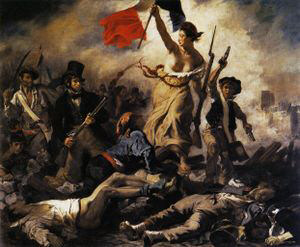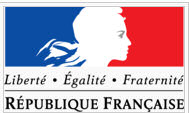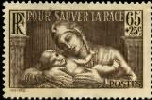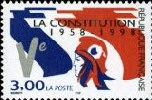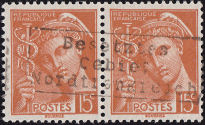French
definitive stamps in historical context
This section will give some help in understanding why particular French definitive
stamps appeared when they did.
Note, French stamps are now colour-coded according to their purpose. Red is used for the standard first-class letter rate, blue for letters to abroad, and green for second-class post, postcards and newspapers.
| 1848
- 1852 |
Second
Republic - Louis Napoleon Bonaparte |
 |
1849 [5] |
Ceres |
20
centimes black
1F vermillion |
designed
and engraved by Jaques-Jean Barre
[Edges cut straight]
[printed by flat letterpress] |
| 1852
- 1870 |
Second
Empire - Napoleon III ( Louis Napoleon Bonaparte) |
 |
1862 |
Napoleon
III |
First perforated French
stamp |
|
| 1870
- 1940 |
Third
Republic |
 |
1870-71
|
Ceres |
Jaques-Jean Barre
Ceres stamps were revived from 1849 issue when Napolean III stamps were forbidden.
They were printed in Paris, using typographic
methods.
At the same time, the provisional government
in Bordeaux printed Ceres stamps. These were printed by Augée-Delile,
using lithography. Thus, there are differences
in clarity of image between Bordeaux and Paris stamps, as can
in the illustration on the left. |
| 1871 |
Franco-Prussian
War ended - Germany won |
| 1871 |
Paris
Commune |
| |
|
|
During
the insurrection of the Paris Commune (1871), Napoleon
III stamps were again printed, while the Parisian printer,
Anatole Hulot, hid the Ceres printing material. |
 |
1876
- 1900 |
Peace and commerce allegoric group
/ Sage type |
“Commerce and peace
unite and peace reigns in the world” |
designed
by Jules-August Sage,
engraved by Louis Eugene Mouchon
[printed by flat letterpress] |
| After
the 1894 competition for a new stamp design failed to choose a
preferred design, three stamp designs were created, used for different
stamp values |
 |
1900
- 1930 |
Blanc type;
Liberty-Egality-Fraternity |
used
for low values - postcards |
designed
by Paul-Joseph Blanc,
engraved by Emile Thomas
The
winged woman carries the scales of justice and the mirror of truth.
[printed by flat letterpress] |
 |
1900 |
Rights
of man / Mouchon type |
used for intermediate values |
designed
and engraved by Eugene Mouchon for the 1894 competition. The design
was slightly altered for the stamp
[printed by flat letterpress] |
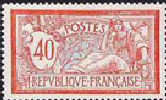 |
1900
- 1920s |
Merson type;
Liberty and Peace allegory |
first
two-colour French stamp;
used for high values |
Luc-Olivier
Merson
The Republic, guardian of the laws and of peace.
[printed
by flat letterpress, in two colours] |
  |
1903 [6] |
The sower |
|
designed
by Oscar Raty,
engraved by Eugene Mouchon.
Replaced
the 1900 Mouchon Rights of Man stamp.
[printed by flat and
rotary letterpress] |
| 1914
- 1918 |
World
War One |
 |
1932
- 1941 |
(left-handed) Peace of Laurens |
The
Repulic holding an olive branch. |
designed by Paul-Albert
Laurens
engraved by Antonin Delzers
[printed by rotary
letterpress]
The design reflects the strength of feeling
for peace between the two World Wars. |
| To replace the
Peace type stamp, three new mythological subjects, Mercury, Iris
and Ceres, were adopted. |
 |
1938 |
Mercury |
used
for low values - printed papers |
designed
and engraved by Georges Hourriez
[printed by rotary letterpress] |
  |
1939
- 1942 |
Iris |
Occupied France - free zone : green,
occupied zone : red |
designed and engraved
by Georges Hourriez
[printed by rotary letterpress] |
 |
1938 |
Ceres |
used
for intermediate values |
after the Ceres
design of Jacques-Jean Barre
[printed
by rotary letterpress] |
| 1940
- 1944 |
The
French State (Vichy Government) |
| Note
that the official French parliament web-site (l’Assemblée
nationale) makes no mention at all of the stamps of the Vichy
goverment, instead listing stamps from Free France and French
territories overseas. |
During the occupation
of France by Nazi Germany, there were 43 issues of stamps.
Many included Petain’s portrait [7],
both in uniform and in civilian clothes. (General Philippe Petain
was head of the Vichy government, installed by the occupying Nazi
Germans.)
Below is featured one issue. |
    |
 |
Jan
1942 - Sept 1944 |
Petain
Bersier series |
|
designed
by Jean-Eugène Bersier
engraved by Jules Pie |
Petain
stamps were banned after France was liberated, but there were
insufficient replacements. Taxed and overprinted Petain stamps
were used, in preference obscuring the traitor Petain’s
face.
There were some two hundred overprints, some official,
some not. This
page [in French] lists many of the overprint texts used in
different towns. |

image credit: Max
Derouen |
 |
1943 |
Work,
family, country |
The slogan
of the Vichy government; stamps produced for Petain’s 87th
birthday. |
| 1943-1944 |
Free
France and French territories |
 |
1944 |
First
occurence of the Gallic cock on a stamp. |
The cross of Lorraine and
the RF monogram also present. |
designed
by Henry Razous,
engraved by Charles Hervé
[“stone lithography”] |
  |
from March 1944 - Corsica,
Algeria; November 1944 - Paris |
Marianne
of Algers (or of Fernez) |
ordered
by Charles de Gaulle at the end of the war and issued by the Provisory
Government |
designed by Louis Fernez,
engraved by Jamignon,
lithographic printing on stone by
Charles Hervé,
printed at l’Atellier Carbonnel,
Algeria. |
| 1944
- 1947 |
Provisional
Government of the French Republic |
 |
issued
October 1944 in Paris |
Arc de triomphe
de l'Étoile
[Offset lithography] |
Printed
in the United States. Gen. de Gaulle refused their use in the
free sector of France |
designed by WA Roach
engraved
by CA Brooks, AW Christensen, T. Vail, JS Edmonson.
Because
the horizontal, and then the vertical, dentallations were cut
separately, often the printed image badly centred on the stamp.
Note
the stamps have “France” on the rather than the French
term, “République française”. |
 |
1944
- 1945
first issue: March 1945 |
Dulac
Marianne |
Provisory Government issue, used
only until the Paris l'Atelier des Timbres-Poste could restart
work |
designed by Edmund Dulac
engraved by Leonard
Phillips, at Thomas de La Rue, London.
Printed by de La
Rue.
Gen. de Gaulle allowed these stamps to be used in the
free sector of France. |
 |
1945 |
Mazelin
Ceres |
|
designed by Charles Mazelin
engraved by Henri Cortot
[printed by rotary intaglio]
Not
as delicate as the orginal Barre Ceres of
1849, this Ceres was only used for two years. |
 |
1945
- 1954 |
Gandon Marianne |
|
designed
by Pierre Gandon
engraved by Henri Corot
[printed
by rotary letterpress] |
| 1947
- 1958 |
Fourth
Republic |
 |
1955
- 1959 |
Muller Marianne |
|
designed
by Louis-Charles Muller
engraved by Jules Piel
[printed
by rotary letterpress] |
 |
1957 |
Reaper |
|
designed
by Louis Muller
engraved by Jules Piel
[printed by
rotary letterpress] |
| 1958 |
Fifth
Republic |
| 1958 |
Charles
de Gaulle |
 |
1959
- 1960 |
Marianne à la Nef |
|
designed
by André Regagnon
engraved by Jules Piel
[printed
by rotary letterpress] |
 |
1960 |
Decaris
Marianne |
|
designed by Albert Decaris
engraved by Jules Piel
[printed by rotary letterpress] |
 |
1961
- 1965
1966 - 1967 |
Cocteau Marianne |
second issue with increased prices |
designed by Jean Cocteau
engraved by Albert Decaris
[printed by rotary intaglio] |
| 1962 |
Algerian
Independence |
 |
1962 |
Decaris
Cock [8] |
3 colours |
designed
and engraved by Albert Decaris
[printed by rotary intaglio] |
 |
1967
- 1969 |
Cheffer Marianne |
|
designed by Henri Cheffer (drawn in 1954)
engraved by
Claude Durrens after Henri Cheffer died in 1957
[printed
by rotary intaglio] |
| 1969 |
Georges Pompidou |
 |
1971
- 1974 |
Béquet Marianne |
|
designed
by Pierre Béquet,
engraved in relief by J. Miermont,
engraved as intaglio dies by Béquet
[printed by rotary
intaglio]
[printed by rotary intaglio] |
| 1974-1981 |
Valéry Giscard d’Estaing |
 |
1977
- 1981 |
Sabine Marianne |
|
designed
and engraved by Pierre Gandon |
| 1981 |
President
François Mitterand |
 |
1982 |
Liberté |
|
designed
and engraved by Pierre Gandon
[printed by rotary intaglio] |
| 1988 |
President
Jacques Chirac |
 |
1989
- 1996 |
Briat Marianne
Marianne
du Bicentenaire |
first self-adhesive
stamps |
designed by Louis Briat
engraved by Charles
Jumelet
[printed by rotary intaglio] |
| 1989 |
200th
anniversary of the French Revolution |
 |
1997
- 2004 |
Luquet Marianne
Marinne
du 14 juillet |
|
designed by
Eve Luquet
engraved by Charles Jumelet
[printed by
high speed rotary intaglio] |
 |
2005 |
Lamouche
Marianne
Marianne des Français |
|
Designed
by Thierry Lamouche
[printed by high speed rotary intaglio] |
| 2007 |
President Nicholas Sarkozy |
 |
2008 |
Marianne de Beaujard
Marianne et l'Europe |
|
Designed by Yves Beaujard
[printed by high speed rotary intaglio] |
| 2012 |
President François Hollande |
 |
2013 |
Marianne de la Jeunesse |
|
Designed by David Kawena and Olivier Ciappa
based on comic strip and manga drawings.
The Marianne portrait is based on Inna Shevchenko, of the lesbian activist organisation, Femen. |
| 2017 |
President Emmanuel Macron |

|
2018 |
Marianne l'engagée |
|
Designed by Yseult Digan/YZ (pronounced Eyes, eyes in English), street artist.and Elsa Catelin, engraver of the La Poste printers.
"I wanted this Marianne to be strong, proud and willing, with a frank look to the future."
According to President Emmanuel Macron, this "committed Marianne" is "the new face of the Republic". |
For those readers who are adventurous and trust their command of French,
here is a
twenty-question quiz on Marianne stamps.

|
the
origin and history of Marianne
Marianne
appears to have come from the name Marie-Anne, which was a common
forename during 18th century France. For the aristocracy, Marie-Anne
was not a worthy name and was considered as pejorative in their
social circles because it represented the people.
The
revolutionaries adopted the name Marianne to symbolise the change
of regime; but above all it incarnated the symbol of “the
mother country”, the mother who nourished and protected
the children of the Republic.
Other sources
say that the name originates from 1797, when Barras, a member
of the Directorate, chose the first name of the wife of one of
his friends, Reubelle, to represent the new regime. The name fulfilled
the conditions of simplicity and lack of royalist connotation.
At
that period, there was also a revolutionary Occitane song, la Garisou de Marianno [la Guérison de Marianne,
or the healing of Marianne] that used this forename to refer to
the Republic.
Later, during the Restoration
and the Second Empire, Marianne became the code name for a
clandestine Republican society.
The
image of Marianne and her Phrygian cap have their origins in antiquity.
The Phrygian cap was worn by slaves emancipated from the Greek
and Roman Empires. Thence, they were citizens, not slaves.
 The
first representations of a woman in a Phrygian cap were made during
the period of the French Revolution. Sailors and galley crew from
the Mediterranean regions wore caps that were practically the
same design. When they joined the Revolution, they brought the
cap to Paris. The
first representations of a woman in a Phrygian cap were made during
the period of the French Revolution. Sailors and galley crew from
the Mediterranean regions wore caps that were practically the
same design. When they joined the Revolution, they brought the
cap to Paris.
A Phrygian cap is a soft, red
felt cap covering the ears, with a rounded top that is pulled
forward. Phrygia was part of Anatolia in Turkey. One of its kings
was Midas of whom it was alleged that everything he touched turned
to gold.
During the Third
Republic, Marianne was represented by statues, often put in
town halls [mairies]. She wore the Phrygian cap to emphasise
her revolutionary character, but this was sometimes regarded as
a call to revolt, and the cap was replaced by a wreath or tiara
to give Marianne a character of greater wisdom.
From
1789 (start date of the French Revolution) females appeared in
paintings and statuary, where they expressed the values of liberty
and revolution with their Phrygian cap and sometimes a decorated
lance. When the Marianne wore a long tunic dress, she was formal
and conquering.
A decree of 1792 arranged that
the “state seal would be changed and would have representing
France a woman dressed as in Antiquity, standing, holding in her
right hand a lance surmounted by a Phrygian cap, or cap of liberty,
her left hand resting on a bundle of arms, and at her feet a tiller”.
She would also have at her feet tables with the law and the Declaration
of the Rights of Man presented to the world.
After
1799, the end of the Republic and the start of the First Empire
weakened the representation of Marianne, even if the theme of
liberty endured. Her name reappeared for a time during the Second
Republic, but generally took a negative sense.
Napoleon
III, the new emperor, replaced Marianne on coins and stamps with
his own portrait. The 1870 Commune of Paris developed a cult of
a female revolutionary fighter with bare breasts wearing a Phrygian
cap of the sans-culottes [9],
but she was not called Marianne.
Under the
Third Republic, two models competed - the statue with a wreath
of wheat and the statue with the Phrygian cap. The first represented
a moderate Republic, while the second a revolutionary Republic,
the people’s republican called Marianne.
As
the Third Republic settled in, busts multiplied in the mairies
and schools. A uniform model generally was used, being a bust
of a woman with a young and calm face, sometimes wearing a wreath
of wheat, but more often wearing a Phrygian cap. TheFrench often refer to such a bust as "the bust of the Republic" by the French.
The
assimilation of the Marianne into the French Republic has now
been achieved. Marianne has survived through five Republics and
through the upsets of history. The most recent designs of Marianne
are popular in town halls, with the features of celebrities like
Brigitte Bardot, Catherine Deneuve and Laetitia Castra.
Marianne
part 2: town hall statues

some
related websites
[All sites in French unless otherwise
indicated]
Cercle
des Amis de Marianne, now continuing in blog form.
La
Poste
L’Assemblie
nationale
comprehensive
online search for French stamps - at the bottom of the linked
web-page
complete
list of French stamps
French
history - dates (in English)

end notes
 After
the fall of France, the remnants of the French Army
retreated to England, regrouping around General de Gaulle
in London under the name Free France. The French stamp
printers (l’Atelier des Timbres-poste) were now
in German-occupied Paris. De Gaulle commissioned a Frenchman
in London, Edmond Dulac, to design a stamp (to be printed
in London) to rally the French colonies to Free France.
However, because de Gaulle would not accept the design,
only about 5,000 copies were produced. One of the stamps
de Gaulle preferred was the Algers Cockerel. This stamp
included a cross of Lorraine, symbol of Joan of Arc
and adopted by the Free French forces. After
the fall of France, the remnants of the French Army
retreated to England, regrouping around General de Gaulle
in London under the name Free France. The French stamp
printers (l’Atelier des Timbres-poste) were now
in German-occupied Paris. De Gaulle commissioned a Frenchman
in London, Edmond Dulac, to design a stamp (to be printed
in London) to rally the French colonies to Free France.
However, because de Gaulle would not accept the design,
only about 5,000 copies were produced. One of the stamps
de Gaulle preferred was the Algers Cockerel. This stamp
included a cross of Lorraine, symbol of Joan of Arc
and adopted by the Free French forces.
Later, in 1943, Dulac entered a stamp design competition
for French artists in England and his design was accepted,
becoming known as the Marianne of London. The stamps
were first sent to Paris at the end of August 1944.
-
 |
| [La Louvre
Museum, Paris] |
From Sabines arrëtant
le combat entre les Romains et les Sabins - Sabines
stopping the fight between the Romans and the Sabins.
Hersilie is standing with arms open to stop her Roman
husband from throwing a javelin at her father-in-law,
Tatius, king of the Sabins.(Hersilie had been kidnapped
some years before by the Romans, a common way for Romans
to obtain new young brides.)
Pierre Gandon used as his model, the face of the Sabine
in a painting at the Louvre - L’enlèvement
des Sabine [the kidnapping of the Sabines] by Jacques-Louis
David, 1799
The legend “France”, which conformed to
the Universal Postal Union rules, was replaced by “Republique
Française” in 1981 after the election of
President François Mitterand.
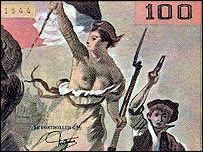 After
the principal person in the painting La
Liberté guidant le peuple [Liberty guiding
the people] by Eugene Delacroix, painted soon after
deposition of King Charles X by the July 1830 Revolution.
This Liberty image used to figure on 100 franc notes. After
the principal person in the painting La
Liberté guidant le peuple [Liberty guiding
the people] by Eugene Delacroix, painted soon after
deposition of King Charles X by the July 1830 Revolution.
This Liberty image used to figure on 100 franc notes.
- Definitive stamps are the standard stamps that are sold year after
year. Commemoratives were originally
made to commemorate a special event. More recently,
commemoratives have been issued in order to raise revenue
rather than celebrate an event, with some minor event
being used as a fig leaf.
- The
first stamp paid for by the sender, rather than the
receiver, was the Penny Black, issued on 6 May 1840.
The stamp showed a side portrait of Queen Victoria at
age 15. The idea of pre-paid postage had been developed
by Rowland Hill.
The first French postage
stamp was issued on 1 January 1849. Its value was 20
centimes. Its colour was black, and had a portrait of
Ceres (as illustrated), goddess of harvest and agriculture.
In 1849, France was a rural and agricultural society
so the choice of Ceres to represent the Republic was
appropriate.
The colour was soon changed from black to red, as the
black franking could not easily be distinguished and
so stamps were being reused. Because the 40 centime
stamp was originally red, its colour was changed to
blue at this time.
- Printing: to
follow.
 Several issues of
the sower appeared, in various series. Firstly, the
lined sower, named after the lines on the background,
had two major series, firstly from 1903 to 1907, then
from 1924 to 1929, with the colours and the values changing.
The lined sower had a further outing from 1960 to 1965,
this time engraved by Jules Piel. The lines were to
give an impression of intaglio printing, a more prestigious
printing form than the letterpress printing actually
employed. Note that the sower is sowing against the
wind. Several issues of
the sower appeared, in various series. Firstly, the
lined sower, named after the lines on the background,
had two major series, firstly from 1903 to 1907, then
from 1924 to 1929, with the colours and the values changing.
The lined sower had a further outing from 1960 to 1965,
this time engraved by Jules Piel. The lines were to
give an impression of intaglio printing, a more prestigious
printing form than the letterpress printing actually
employed. Note that the sower is sowing against the
wind.
 The cameo sower, also known as the plain background
sower, is sometimes called La Semeuse grasse, the fat
sower. The word ‘fat’ refers to the heavy
letters used for the stamp’s value. The cameo sower, also known as the plain background
sower, is sometimes called La Semeuse grasse, the fat
sower. The word ‘fat’ refers to the heavy
letters used for the stamp’s value.
The allegory of the sower was already on coins since
1897. She embodies a rural Republic which was a stamp
symbol for more than 30 years. The design was planned
originally for a agricultural medal. Roty made a plaster
cast to serve as the engraver’s model. However,
transferring the design from 3-D low-relief to a 2-D
stamp was not easy.
This stamp was printed on mass production paper to take
into account the shortage of paper at that time.
- Mercury is the
god of commerce and eloquence, patron of merchants and
travelers. As messenger of the gods, Mercury also embodies
the modern god of messengers carrying the post.
Originally issued with the legend “République
française”, in 1942 this stamp bore
the words “Postes françaises”,
and from 1944, was overprinted with “RF”.
- Iris, as a messenger
of the gods, carries a torch to light the road.
Printing took place in two places: first in Paris, then,
between September 1939 and September 1940 in Limoges.
But the Iris type is best known for being printed on
interzonal postcards. From September 1940, it was the
only method of correspondence permitted by the Germans
between the free zone and the occupied area. The Iris
type reappeared in September 1944 with a Republican
legend.
- This stamp was derived
from the Jacques-Jean Barre Ceres of 1849, and was reserved
for intermediate values. Modifications were made to
the frame of the legend and the face value. The engraving
of the stamp, which bears no signature, was done at
the stamp printing Workshop. Priinting was done at Paris
and Limoges. The stamp printing Workshop was moved to
Limoges the beginning of the war.
- Only
two French heads of state, Louis-Napoleon
Bonaparte and Philippe
Pétain, have wished their portrait to appear
on stamps contrary to the Republican tradition, with
the principle that a personality is not put on a stamp
while they are still living. However, these two heads
of state did have the excuse that they were not Republicans.
However, La Poste (the French Post Office) has sometimes
slipped up, for instance producing stamps showing portraits
of Ginette Leclerc and Jean-Pierre Cargol, while still
living, in the French Cinema series of 1986. Another
still living French personality on a French stamp is
Jean-Claude Killy, 6 times world champion and 3 times
Olympic champion, twice world cup winner amongst many
other sporting successes.
The two first Napoleon III stamps, produced before he
was proclaimed emperor still included the words “Repub.
Franc.”, following stamps had instead “Empire
Franc.”
- At the end of 1943,
Corsica was the only French department to be liberated.
Cut off from the mainland, the island soon had no stamps,
so on 6 December 1943, the French Committee of National
Liberation (CFLN) in Algiers made a temporary solution
by introducing stamps made in the Free French territory
of Algeria. In May 1944, the CFLN became the Republic’s
provisional government.
Louis Fernez was the prize-winning Algerian painter
who was entrusted with the design of the first Marianne
of France. There was sufficient printing materials -
lithographic stone - in Algeria. This stone had already
been used to print stamps designed by Jules Carbonel.
The work was entrusted to the lithographer Charles Hervé.
This provisional Marianne disappeared in May 1945.
- The Gallic
cock decorated the French flag during the 1789 revolution.
In 1830, he replaced the fleur-de-lys, the royal emblem.
In 1852, he was chased away by the Empirial eagle, but
returned in 1962 on a tricolour [blue, white, red] stamp.
The cockerel, gallus gallus, has been a French
symbol since Roman times. The French appreciate the
play on words: the Roman word for cock, gallus,
was also used by the Romans to name the French people
of that period - the Gaulois.
- Sans-culottes means without breeches. This label was applied by the
richer classes in 18th century France, who could afford
smart, fitted knee-breeches, to the poorer, working
classes, in particular around Paris, who wore ill-fitting
pantaloons. Specifically, the term referred to “the
ill-clad and ill-equipped volunteers of the French Revolutionary
army”.
- The tricolour of the
French national flag - blue, white, red - combines the
colours of Paris (red and blue) with the colour of the
king (white).
These colours appeared during the first days of the
French Revolution. In July 1789, a little before the
taking of the Bastille prison (14th July), there was
a great general unrest in Paris. A militia was raised,
which wore a cockade composed of the ancient colours
of Paris - red and blue. On the 17th July, Louis XI
went to Paris to review the new National Guard. The
Guard was wearing the cockade of red and blue, to which
(apparently) the Lafayette, the Guard commander added
the royal white.
The law of 27 pluviôse year II (15 February 1794) made the tricolour the
national flag of France and, following the recommendation
of the artist David, stipulated that the blue should
be attached to the mast.
-
French governments from 1792 to present
- First Republic: 1792 - 1804
- First Empire: 1804 - 1814
- Restoration
of the Bourbons: 1814 - 1848
- Second Republic: 1848 - 1852
- Second Empire: 1852 - 1870
- Third Republic: 1870 - 1940
- The French State (Vichy Government): 1940 -
1944
- Provisional government of the French Republic:
1944 - 1947
- Fourth Republic: 1947 - 1958
- Fifth Republic: 1958 - present
- The group
represents an allegory of the Republican trilogy, Liberty-Egality-Fraternity,
symbolised by a winged woman holding the scales of justice
and the cherubs who embrace each other.
- These stamps
show an allegoric representation of Liberty and Peace.
- While in
the unoccupied zone of France under the Vichy government,
with new stamps were issued from November 1940, in the
occupied zone things were different.
Existing stamps were overprinted by the Germans with
a franking-type stamp. The stamp read Besetztes
/ Gebiet / Nordfrankreich - Occupied Zone Northern
France.
|










 site map
site map